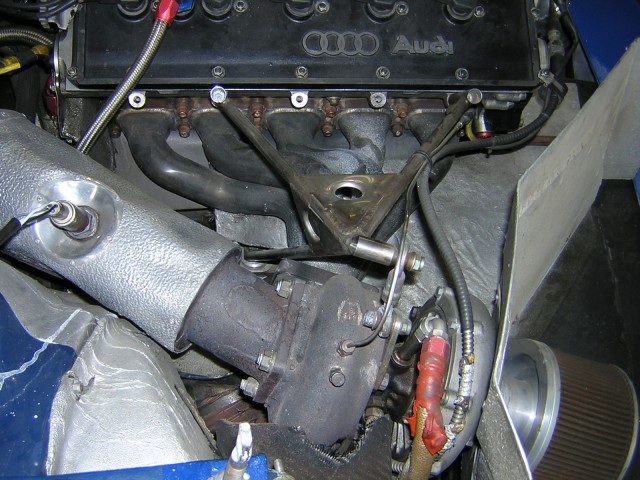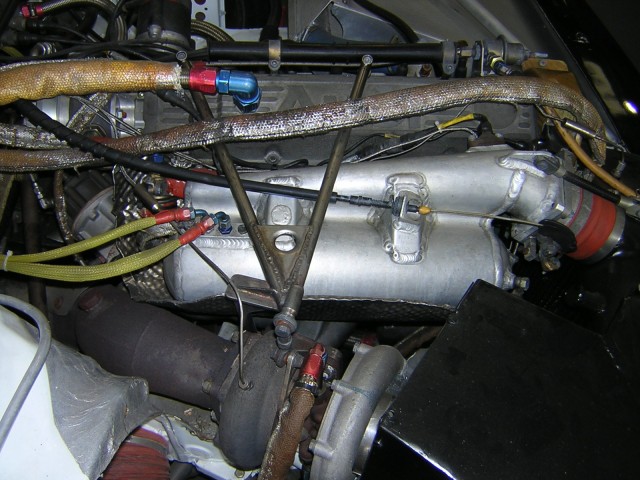New Turbo Kit in the works.
#81
2 Props,3 Dildos,& 1 Cat


iTrader: (8)
Join Date: Jun 2005
Location: Fake Virginia
Posts: 19,338
Total Cats: 573
the uneven temperature distribution in the manifold is what causes the cracking. look at manifolds with a 1/2 flange (no cuts). There's no way the flange expands the same as the head. but the rest of the manifold will have hot and hotter spots.
example: take a glass (low thermal conductivity) and heat it up and then stick the top into an ice water bath. temperature differential = hide the pieces before the wife sees them!
example: take a glass (low thermal conductivity) and heat it up and then stick the top into an ice water bath. temperature differential = hide the pieces before the wife sees them!
#82
y8s, there a lot of other considerations that play into exhaust manifold cracking, but there's a big factor that comes up when we're talking 304SS vs MS: fatigue due to the thermal strains that result when manifolds are subjected to repeated cycles of heating and cooling. It's less of a thermal conductivity thing than it is a thermal expansion thing.
#83
Elite Member

iTrader: (9)
Join Date: Jun 2006
Location: Chesterfield, NJ
Posts: 6,892
Total Cats: 399
the uneven temperature distribution in the manifold is what causes the cracking. look at manifolds with a 1/2 flange (no cuts). There's no way the flange expands the same as the head. but the rest of the manifold will have hot and hotter spots.
example: take a glass (low thermal conductivity) and heat it up and then stick the top into an ice water bath. temperature differential = hide the pieces before the wife sees them!
example: take a glass (low thermal conductivity) and heat it up and then stick the top into an ice water bath. temperature differential = hide the pieces before the wife sees them!

The flange and head will expand at different rates because the head is aluminum and the flange is SS or mild steel. Right? The head flange of the manifold will be the coolest part of your manifold.
#84
Elite Member

iTrader: (9)
Join Date: Jun 2006
Location: Chesterfield, NJ
Posts: 6,892
Total Cats: 399
y8s, there a lot of other considerations that play into exhaust manifold cracking, but there's a big factor that comes up when we're talking 304SS vs MS: fatigue due to the thermal strains that result when manifolds are subjected to repeated cycles of heating and cooling. It's less of a thermal conductivity thing than it is a thermal expansion thing.
With the broken glass, the glass breaks because of the internal stresses from thermal expansion. The cold side will shrink, not conduct the heat away from the hot side (low thermal conductivity), and go ka boom.
We are all saying the same thing.
#87
Usually with turbo supports, you want to design it to allow the manifold to expand, grow and move around but still keep the turbo's weight supported elsewhere (e.g. so the manifold doesn't have to support the weight). This goal means that end up with a turnbuckle/clevis/heimjoint hanger thing. These do a great job of supporting the turbo's weight while still allowing for movement.
However, the problem with the hanger approach is that it doesn't really increase the natural frequency of the manifold/turbo system, which is what you want.
So with all that in mind, I would say it is best to support the turbo from the block with some beefy bracketing. Mitsubishi does this on the Evo--they have a short, beefy brace that ties the turbo to the block.
Just for kicks, here are examples of heimjoint hangers on some older Audi motorsport (IMSA?):


#90
2 Props,3 Dildos,& 1 Cat


iTrader: (8)
Join Date: Jun 2005
Location: Fake Virginia
Posts: 19,338
Total Cats: 573
 the head flange doesn't, the collector does. the point is: when part of it is hot and expanding and another part is cooler and expanding less... you get stress. if the CTE is lower, that stress will be lower. stress leads to anger, anger leads to hate, hate leads to the dark side! i mean cracking. mmmm. crack you will.
the head flange doesn't, the collector does. the point is: when part of it is hot and expanding and another part is cooler and expanding less... you get stress. if the CTE is lower, that stress will be lower. stress leads to anger, anger leads to hate, hate leads to the dark side! i mean cracking. mmmm. crack you will.so Jay, you reiterated the 304 vs. Mild is the debate at hand. and since you worked in the industry... what's the science say about which is better and why?
#94
The mechanism is the thermal fatigue. Barring all the vibration related stuff we were talking about, you usually see cracking in the HAZ of the collector (since it sees the highest temp excursions) or primaries.
The corrosion resistance, strength at temp (and creep if memory serves) of mild is unacceptably low for a turbo manifold. You need nickel and chromium in a cast manifold (both of which mild lacks), so D5 Ni-Resist at a minimum and preferably a stainless.
#95
Well the only real issue with stainless is that the heat of the welder can cause the metal to warp (welder is hotter than exhaust, obviously), so you have to keep checking fitment constantly during fabrication. So most of the time its easier to use mild steel for the flange. Plus it doesnt matter after its on the car because as you said, the flange is the cooler part of the manifold. The manifold tubing itself however, IMHO is best made out of stainless, because 1, less underhood heat. 2 The reason manifolds crack not only has to deal with expansion but the rate at which it expands. Because of the higher thermal conductivity, mild steel not only heats up very quickly, but it also cools very quickly. You used the example of glass. When glass is made it must be put in various staged ovens to control how fast it cools from the operating temp of molding glass back to room temperature. Stainless Steel may have a higher expansion rate, but because of lower thermal conductivity it takes much longer to cool after it reaches a set temperature. You have to look at the thermodynamics in both ways. Slow to heat=slow to cool=slow expansion=slow contraction. Mild steel however is going to be quick to heat=quick to cool=quick to expand(even if it is less)=quick to contract. This rapid expansion and contraction is what cracks welds and manifolds. Which again is why cast steel manifolds crack when they have no welds.
You also have to look at it in terms of gauge of the steel being used. if you use a thicker mild steel than stainless, which is usually the case, think about it like this, you heat a sheet of metal and put it in water, doesnt crack, you heat a cube of metal and put it in water, probably cracks or warps very badly. Not because of surface area, but beause of the volume that is heated, (the outside would cool faster than the inside, causing stress.)
#96
Let me show you some empirical data to back up my claim why stainless is better:
The coefficient of thermal expansion of Stainless Steel (304): is 9.6 (in/in/F*10*-6)
Mild Steel is 6.7
I assume this is a linear coeffiecient, so
coefficient=(1/l)(∂l/∂T) or (1 /by length) times (change in length/change in temp)
so if we know our length (12 inches) and our change in temperature (say 500F)
so 6.7(in/in/F*10^-6)=(1/12in) (L in/500F*10^-6)
6.7(in/in/F*10^-6)/0.08333in=(L in/500F*10^-6)
80.4(in/F*10^-6)=(L in/500F*10^-6)
80.4(in)=(L in/0.0005)
80.4in*.0005=change in length
linear thats a change of .0402 in if you heat it up 500 degrees F
for stainless its .0576
so we are talking a difference of 0.0174 inches at 500 degrees F, that one hundredth of an inch, with 1 foot of metal.
Thats not significant.
however the thermal conductivity is significant.
its in BTUs (per hour per foot per degrees F)
Stainless is 8.09
Mild Steel is 26.0-37.5 depending on contents (mild steel content usually varies)
I dont think you need me to calculate that out to see the difference.
Everyone follow that?
The coefficient of thermal expansion of Stainless Steel (304): is 9.6 (in/in/F*10*-6)
Mild Steel is 6.7
I assume this is a linear coeffiecient, so
coefficient=(1/l)(∂l/∂T) or (1 /by length) times (change in length/change in temp)
so if we know our length (12 inches) and our change in temperature (say 500F)
so 6.7(in/in/F*10^-6)=(1/12in) (L in/500F*10^-6)
6.7(in/in/F*10^-6)/0.08333in=(L in/500F*10^-6)
80.4(in/F*10^-6)=(L in/500F*10^-6)
80.4(in)=(L in/0.0005)
80.4in*.0005=change in length
linear thats a change of .0402 in if you heat it up 500 degrees F
for stainless its .0576
so we are talking a difference of 0.0174 inches at 500 degrees F, that one hundredth of an inch, with 1 foot of metal.
Thats not significant.
however the thermal conductivity is significant.
its in BTUs (per hour per foot per degrees F)
Stainless is 8.09
Mild Steel is 26.0-37.5 depending on contents (mild steel content usually varies)
I dont think you need me to calculate that out to see the difference.
Everyone follow that?
#97
Elite Member
iTrader: (2)
Join Date: May 2007
Location: Cromwell, Connecticut
Posts: 2,604
Total Cats: 16
jc_rotor i absolutely hate you....
here i am, trying to take a study break before my big mechanics of materials test 2morro...decided to check MT.net and, oh what do i see...... more ******* deformation formulas......
I CANT CATCH A BREAK!
δ = α *ΔT* L
lol
here i am, trying to take a study break before my big mechanics of materials test 2morro...decided to check MT.net and, oh what do i see...... more ******* deformation formulas......
I CANT CATCH A BREAK!
δ = α *ΔT* L
lol
#98
Elite Member

iTrader: (9)
Join Date: Jun 2006
Location: Chesterfield, NJ
Posts: 6,892
Total Cats: 399
If differential CTE was the primary factor in cracking, then the cracks would always be right at the flange-to-runner intersections. But they rarely are.
The mechanism is the thermal fatigue. Barring all the vibration related stuff we were talking about, you usually see cracking in the HAZ of the collector (since it sees the highest temp excursions) or primaries.
The corrosion resistance, strength at temp (and creep if memory serves) of mild is unacceptably low for a turbo manifold. You need nickel and chromium in a cast manifold (both of which mild lacks), so D5 Ni-Resist at a minimum and preferably a stainless.
The mechanism is the thermal fatigue. Barring all the vibration related stuff we were talking about, you usually see cracking in the HAZ of the collector (since it sees the highest temp excursions) or primaries.
The corrosion resistance, strength at temp (and creep if memory serves) of mild is unacceptably low for a turbo manifold. You need nickel and chromium in a cast manifold (both of which mild lacks), so D5 Ni-Resist at a minimum and preferably a stainless.











